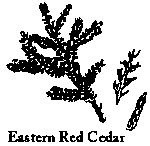| Honey Locust (Gleditsia triacanthos)
can reach a height of 75 feet and 30 inches in diameter. On old trees,
the bark is dark gray divided into tight scales. Strong, sharp, shiny
thorns grow on the first year old wood remaining for many years and help
identify the tree. The leaf is feather-like with leaflets. |

|
| Sugar Maple (Acer
saccharum) with lobed leaves growing in pairs, most maples are easy
to distinguish from other trees. Maples also have distinctive fruits
called samaras - winged, paired seeds that spin to the earth like tiny
helicopters. Sugar Maple's sap contains enough sugar to warrant commercial
tapping and boiling for sugar. |

|
| Red Maple (Acer rubrum)* grows
to be 50 to 70 feet tall with leaves two to six inches wide. The
Red Maple flowers with red in springtime and grows in swamps and bottom
lands giving it the nickname "Swamp Maple". |

|
| Black Cherry (Prunus serotina)*
has glorious spring blossoms and fruits. It grows up to 60 feet tall
and has long tapered leaves with rounded teeth and rusty hairs along the
underside. The flowers grow in long clusters and the fruits turn
black when ripe. |

|
| Black Locust (Robinia pseudoacacia)*
was taken to Europe about 1600, one of the first North American trees to
be introduced into the Old World. Its decay-resistant wood makes
excellent fence posts, railroad ties and grapevine stakes. |

|
| Eastern Red cedar (Juniperus virginiana)*
invades abandoned fields where other trees cannot grow or have not become
established. They serve as pioneers, creating an environment hospitable
to the growth of broad-leaved trees. Cedar chests are made from the
fragrant wood of the Eastern Red Cedar. |

|
| American Holly (Ilex opaca)* is
found most often in moist places and includes 14 species in Eastern North
American forests. These trees are most prominent in autumn, when
the female plants bear bright red fruits beloved by song and game birds. |

|
| Bamboo-Giant Cane (Arundinaria)*
is among the 60 groups of the bamboo family. Only the Giant Cane
is native to North America. It flowers only once every 40 to 50 years.
The tough, woody stems grow from 5 to 30 feet tall forming dense thickets. |

|
| American Beech (Fagus grandifolia)
has leaves that may stay on the tree all winter, twisting and rustling
in the wind. This tree is unmistakable with its thin gray bark and
papery leaves. |

|
| Scarlet Oak (Quercus coccinea)
grows to be 80 feet tall with three to six inch long leaves. Their
bitter acorns require two years to mature. Of all the broad-leaved
trees in North America, oaks are the most widespread, occupy the greatest
variety of habitats, and comprise the largest number of species. |

|
| Northern White Oak (Quercus alba)
reaching heights up to 100 feet tall. Its large leaves have seven
to nine major lobes. The acorn cup is shallow with knobby scales.
The wood is commonly used for furniture, flooring and whiskey barrels. |

|
| Southern Red Oak (Quercus falcata)
usually grows to 70 or 80 feet and two to three feet in diameter.
Its large spreading branches form a broad, round top desirable for shade.
the acorns are rounded, with a scaly cup that covers about one-third of
the fruit. |

|
| Yellow Poplar (Liriodendron tulipifera)
is one of the tallest, straightest eastern broad-leaved trees and its trunk
is among the largest in diameter. Its tulip-shaped blossoms are camouflaged
by the green on the outer petals, and only when the blossoms fall prematurely
are the bright inner petals revealed. This tree is also known as
a Tuliptree. |

|
| Short Leaf Pine (Pinus echinata)
has two or three straight needles in a cluster and scaly bark with large
flat plates. This pine is commonly called Forest Pine and is used
for "heart pine flooring". |

|
| Virginia Pine (Pinus virginiana)
has two twisted needles in a cluster and are usually shorter than short
leaf pine needles. The bark is thin, reddish brown and broken into
shallow plates. The lumber is used for rough construction, paper
pulp and firewood. |

|
| Flowering Dogwood (Comus florida)
consists of fifteen North American dogwood species ranging from medium-sized
trees to small wildflowers. The petals of the Flowering Dogwood are
modified leaves, with the tree flowers, greenish yellow in color, clustered
in the center. |

|
| Sycamore (Plantanus occidentalis)*
is easily identified by its buttonball bristly fruit and by its distinctive
mottled bark ranging in color from white, green to black. The leaves
are wide, large toothed, with three to five shallow lobes. |

|
| Black Tupelo or Blackgum (Nyssa
sylvatica) Its name refers to its swampy habitat: "tupelo" comes from
the Native American words for "swamp tree". The oval leaves are dark
green with deep blue berry-like fruits. The bark is gray and the
tree grows 60 to 80 feet. |

|


















 Charlottesville
City Home Page
Charlottesville
City Home Page